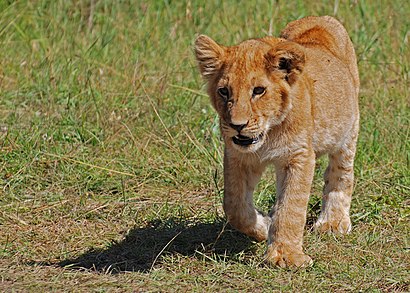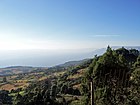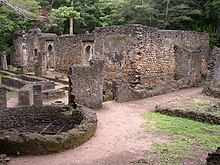Portal:Kenya

Introduction  Kenya, officially the Republic of Kenya (Swahili: Jamhuri ya Kenya), is a country in East Africa. A member of the African Union with a population of more than 47.6 million in the 2019 census, Kenya is the 28th most populous country in the world and 7th most populous in Africa. Kenya's capital and largest city is Nairobi, while its oldest and second largest city, is the major port city of Mombasa, situated on Mombasa Island in the Indian Ocean and the surrounding mainland. Mombasa was the capital of the British East Africa Protectorate, which included most of what is now Kenya and southwestern Somalia, from 1889 to 1907. Other important cities include Kisumu and Nakuru. Kenya is bordered by South Sudan to the northwest, Ethiopia to the north, Somalia to the east, Uganda to the west, Tanzania to the south, and the Indian Ocean to the southeast. Kenya's geography, climate and population vary widely, ranging from cold snow-capped mountaintops (Batian, Nelion and Point Lenana on Mount Kenya) with vast surrounding forests, wildlife and fertile agricultural regions to temperate climates in western and rift valley counties and further on to dry less fertile arid and semi-arid areas and absolute deserts (Chalbi Desert and Nyiri Desert). Kenya's earliest inhabitants were hunter-gatherers, like the present-day Hadza people. According to archaeological dating of associated artifacts and skeletal material, Cushitic speakers first settled in Kenya's lowlands between 3,200 and 1,300 BC, a phase known as the Lowland Savanna Pastoral Neolithic. Nilotic-speaking pastoralists (ancestral to Kenya's Nilotic speakers) began migrating from present-day South Sudan into Kenya around 500 BC. Bantu people settled at the coast and the interior between 250 BC and 500 AD. European contact began in 1500 AD with the Portuguese Empire, and effective colonisation of Kenya began in the 19th century during the European exploration of the interior. Modern-day Kenya emerged from a protectorate established by the British Empire in 1895 and the subsequent Kenya Colony, which began in 1920. Numerous disputes between the UK and the colony led to the Mau Mau revolution, which began in 1952, and the declaration of independence in 1963. After independence, Kenya remained a member of the Commonwealth of Nations. The current constitution was adopted in 2010 and replaced the 1963 independence constitution. Kenya is a presidential representative democratic republic, in which elected officials represent the people and the president is the head of state and government. Kenya is a member of the United Nations, the Commonwealth, World Bank, International Monetary Fund, COMESA, International Criminal Court, as well as other international organisations. With a GNI of 1,840, Kenya is a lower-middle-income economy. Kenya's economy is the second largest in eastern and central Africa, after Ethiopia, with Nairobi serving as a major regional commercial hub. Agriculture is the largest sector; tea and coffee are traditional cash crops, while fresh flowers are a fast-growing export. The service industry is also a major economic driver, particularly tourism. Kenya is a member of the East African Community trade bloc, though some international trade organisations categorise it as part of the Greater Horn of Africa. Africa is Kenya's largest export market, followed by the European Union. (Full article...)
Selected article - The ca. 1000 km long Tana River is the longest river in Kenya, it is also called Sagana River in the Mt Kenya region and gives its name to the Tana River County. Its catchment covers ca. 100,000 km2 and can be divided into the headwaters and the lower Tana consisting of the section downstream of Kora where the river flows for ca. 700 km through semi-arid plains. Its tributaries include some major rivers in the Central Region like Thika, Ragati River, Nyamindi, Thiba ,Mathioya, Chania, Thuci and Mutonga. The river rises from Mt Kenya in Nyeri. It initially runs southwest before turning south around the massif of Mount Kenya and meanders all the way up to the Indian Ocean. A series of hydroelectric dams (the Seven Forks Hydro Stations or the Seven Forks Scheme) has been constructed along the river. These include (in order of cascading) the Masinga Dam (commissioned in 1981 with an installed capacity of 40MW), the Kamburu Dam (1974, 94.20MW), the Gitaru Dam (1978, 225.25MW), the Kindaruma Dam (1968, 72MW) and the Kiambere Dam (1988, 168MW). en The Masinga Reservoir and the Kiambere Reservoir, created by the Masinga and Kiambere dams respectively, serve a dual purpose: hydro-electric power (HEP) generation and agricultural irrigation. The other three are used exclusively for HEP generation. A 2003 study reported that two-thirds of Kenya's electrical needs were supplied by the series of dams along the Tana River. Many people believe this river has groundwater underneath it, but it doesn't. The electricity is then supplied to the national grid system and distributed countrywide through a series of substations, transformers and cables. Below the dams, the river turns north and flows along the north-south boundary between the Meru and North Kitui and Bisanadi, Kora and Rabole National Reserves. In the reserves the river turns east, and then south east. It passes through the towns of Garissa, Hola and Garsen before entering the Indian Ocean at the Ungwana Bay-Kipini area, at the end of a river delta that reaches roughly 30 km upstream from the river mouth itself. It runs through a semi-arid area and irrigates the surrounding land. (Full article...)Selected picture -Selected location -Uasin Gishu County is one of the 47 counties of Kenya. The city of Eldoret (capital and largest town in the county) is the county's administrative and commercial centre. Eldoret is the second largest urban centre in midwestern Kenya and the 5th largest urban centre in Kenya. Uasin Gishu is located on a plateau and has a cool and temperate climate. It borders Trans-Nzoia County, Kenya. (Read more...) This is a Good article, an article that meets a core set of high editorial standards.
The ruins of Gedi are a historical and archaeological site near the Indian Ocean coast of eastern Kenya. The site is adjacent to the town of Gedi (also known as Gede) in the Kilifi District and within the Arabuko-Sokoke Forest. Gedi is one of many medieval Swahili coastal settlements that stretch from Barawa, Somalia to the Zambezi River in Mozambique. There are 116 known Swahili sites stretching from southern Somalia to Vumba Kuu at the Kenya-Tanzania border. Since the rediscovery of the Gedi ruins by colonialists in the 1920s, Gedi has been one of the most intensely excavated and studied of those sites, along with Shanga, Manda, Ungwana, Kilwa, and the Comoros. (Full article...)Selected biography - Mercy Cherono Koech (born 7 May 1991) is a Kenyan professional long-distance runner. She was the silver medalist in the 5000 metres at the 2013 World Championships in Athletics. She is a two-time world junior champion in the 3000 metres (2008, 2010) and has also won gold medals at the 2007 World Youth Championships in Athletics and 2008 Commonwealth Youth Games. She has been a success junior athlete in cross country running, taking the silver medals in the junior team and individual competitions at the 2009 IAAF World Cross Country Championships and improving to the gold medals at the 2010 edition. (Full article...)Related portalsDid you know (auto-generated) -
In the news
Wikinews Kenya portal
Selected panorama -Panorama of Upper Hill, an emerging business district within Nairobi.
General images -The following are images from various Kenya-related articles on Wikipedia.
Topics in KenyaCategoriesAssociated WikimediaThe following Wikimedia Foundation sister projects provide more on this subject:
Discover Wikipedia using portals |










































